
Metrology in fluids, laser diagnostics
The characterization of velocity, temperature and concentration fields, as well as the particle size distribution in two-phase flows, allow the physical phenomena of heat and mass transfer to be apprehended. The platform’s measurement techniques meet the needs of applied and fundamental research and cover a wide range of spatial and temporal scales.
The platform develops optical measurement techniques based on the interaction of light radiation with matter and the scattering of light by particles that can be explored by using lasers. The advantage of these techniques is that they are non-intrusive, which is fundamental for studying most flow configurations. Laser-induced fluorescence, Raman scattering, are generally better suited for measuring temperature and concentration of different species. The determination of particle size by optical means is more specifically dedicated to the study of two-phase flows. It aims at the statistical measurement of the diameters of small particles (typically a few tens of µm) as well as their concentration. Laser velocimetry is based on the scattering of light by fine particles used as tracers of the flow which allows to determine the local velocity of the fluid.
Specificities
- Development of innovative laser optical diagnostics with spatial and temporal resolution
- Characterization of transfer phenomena at different scales (starting from the vicinity of gas/liquid interfaces or liquid/solid interfaces through single droplets, droplet streams and ending by sprays)
- Characterization of two-phase flows by various optical techniques
- Coupling of measurement techniques (size/velocity/temperature) to carry out energy balances
Application sectors
- Two-phase combustion of alternative fuels
- Two-phase cooling
- High heat flow dissipation
- Heat recovery
- Aircraft Icing
Keywords
- Laser induced fluorescence
- Fluorescence spectroscopy
- Laser Doppler velocimetry
- Laser granulometry by Doppler phase analysis
- Raman spectroscopy
- Particle image velocimetry
Several measurement techniques are mastered, in particular:
- Laser induced fluorescence. The techniques can be based on the measurement of the intensity of the LIF signal or on the measurement of the fluorescence lifetime. There are several measurement configurations:
– Planar laser Imaging (PLIF) using cameras
– Pointwise measurements by photomultipliers
– Two-photon fluorescence microscopy
– Fluorescence lifetime imaging
- Raman scattering
Phase Doppler analysis (size and velocity of particles)
The platform has a wide variety of laser sources and detectors (cameras, photomultipliers). Among our equipments, we can mention:
- Doppler effect laser granulometry and velocimetry (PDA). This device is used to characterize the speed and size of particles. In addition, in sprays, the LIF/PDA coupling allows local and simultaneous determination of drop size, velocity and temperature.
- Particle Image Velocimetry (PIV). The implementation of a Dual PIV system allows to determine the velocity and acceleration field of particles (Example: study of the atomization of sprays)
- Raman spectrometer for the visible (300 nm to 1100 nm), fast, with a focal length of 750mm with a cooled 2-dimensional camera
- Two-photon excitation microscope combined with a Ti:Sa femtosecond laser. This microscope allows a three-dimensional movement and rotation of the objective.
- Fluorescence lifetime measurements by Time Correlated Single Photon Counting (TCSPC) technique
Time-resolved fluorescence spectroscopy applied to temperature measurement
A femtosecond laser is used to measure in the time domain the fluorescence lifetime, which is intrinsically dependent on temperature and chemical composition. The measurement is based on the Time Correlated Single Photon Counting Technique (TCSPC). This new approach is a decisive improvement over measurement methods based on signal intensity. In contrast to the latters, an absolute temperature measurement can be obtained. An example of result is the measurement of temperature in sprays.
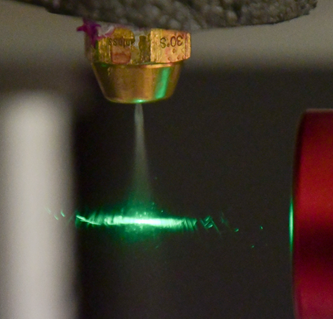
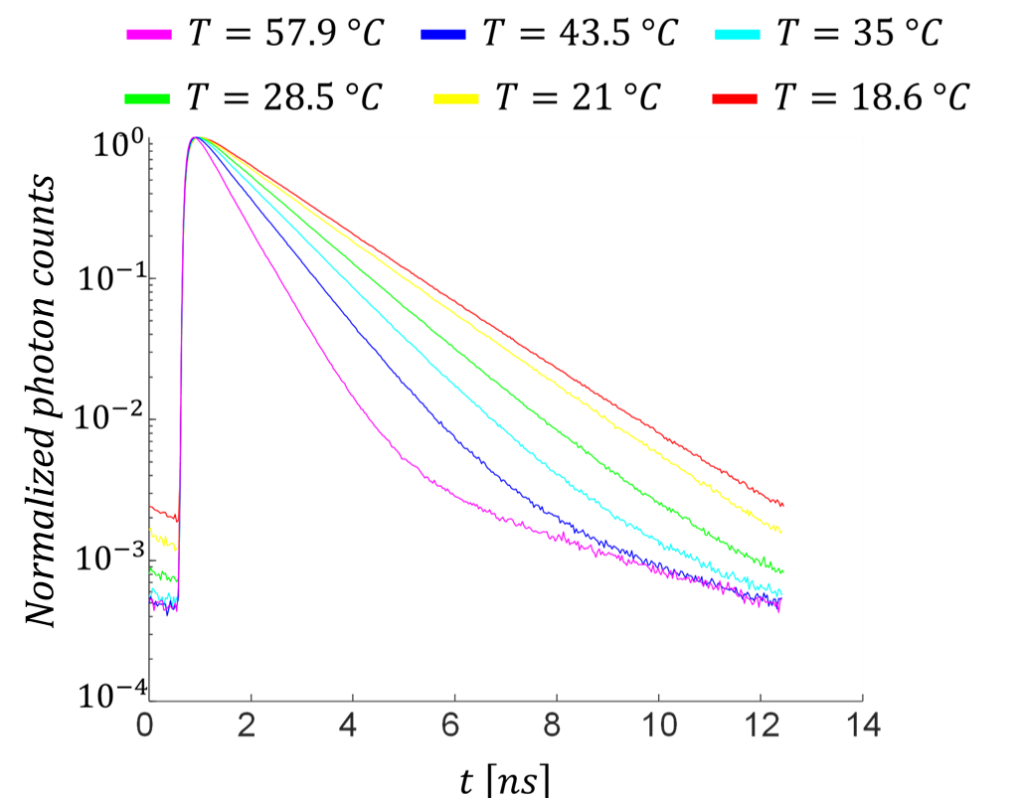
Fluorescence measurement in a spray using a microscope objective
Fluorescence decay of rhodamine B at different temperatures
Images of temperature fields resolved in time and space
The development of fluorescence imaging systems resolved in time and space is a major challenge for the study of transfer phenomena. The use of a pulsed laser source is generally required to record images frozen in time. The saturation of the fluorescence excited by high fluence laser has been studied in depth in order to limit the effects on the temperature sensitivity of fluorescent dyes. Applications include the measurement of the temperature field inside falling liquid films or droplets impinging on heated surfaces.
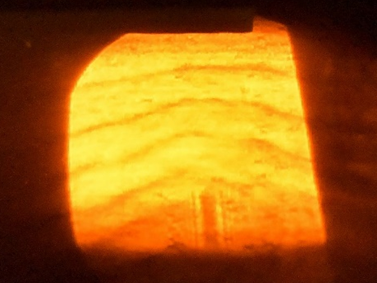

Application of LIF thermometry in thin liquid films (thickness less than 1 mm) illuminated in volume
Reconstructed temperature field in a perpendicular slice of a falling liquid falling heated from below

Temperature field inside a water droplet spreading over a sapphire wall heated at 600°C
Drops in icing conditions
A fluorescence imaging technique, using an high-speed camera and a continuous-wase laser has been developed specifically to meet the challenges of observing the propagation of an ice front inside a drop spreading on a cooled wall during a few ms. The fluorescence signal varies with the thickness of the illuminated liquid layer, allowing the position of the ice front during icing to be determined very accurately. The illustrations concern the icing of a water drop impinging onto a glass wall at -10°C.
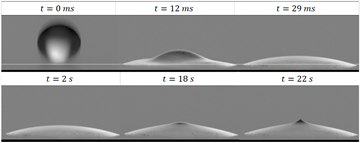
Umborscopy image in side view of the impact of a drop and the icing process
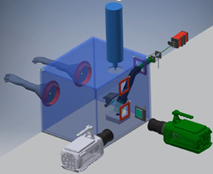

Experimental set-up with two high-speed cameras to investigate the freezing of droplet on a sub-cooled substrate with humidity control
Reconstructions of the solidification front inside a freezing water drop using the fluorescence of rhodamine 6G induced by a laser at 532 nm
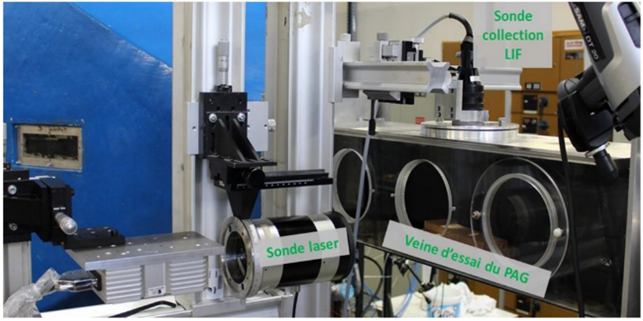
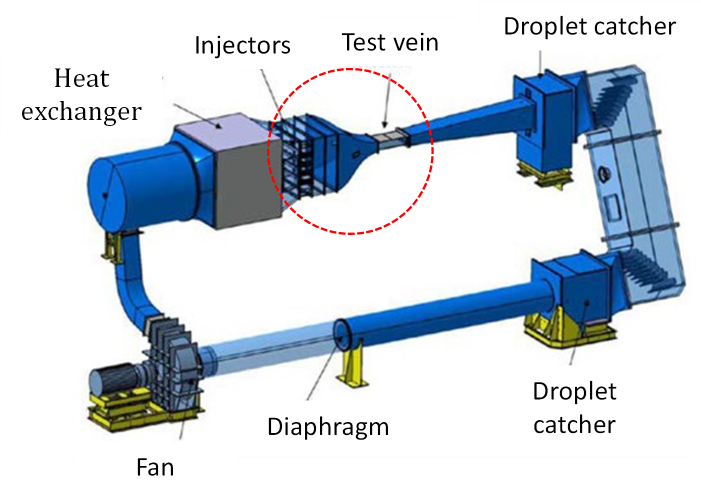
2cLIF assembly placed around the DGA FROSTER TESTING WINDOW (PAG)
Schematic view of the icing wind tunnel
Guillaume Castanet
guillaume.castanet@univ-lorraine.fr
LEMTA
2 avenue de la Forêt de Haye
BP 90161
54505 VANDOEUVRE-LÈS-NANCY CEDEX